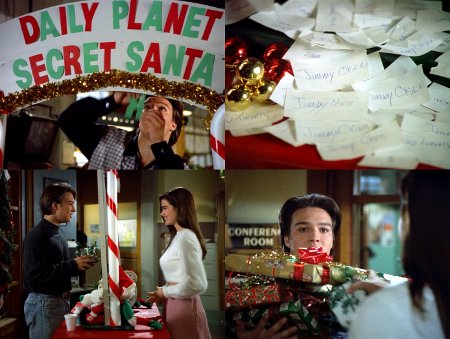“Secret Santa” (sometimes known as Kris Kringle or Chris Kindle) is a Christmas gift-giving game that can be played by three or more people, although the more people playing the better. The tradition is often carried out amongst members of workplaces, social clubs, educational classes, or large families. The game allows many people to each give and receive one gift, thus avoiding the need for individuals to buy everyone a gift, which can become costly.

How to play Secret Santa in a traditional way
- As Christmas approaches, everyone who wants to be involved should gather in one room. The names of the participants are then written on similar pieces of paper that are folded and placed in a hat or sack.
- Without looking, each participant grabs one of the folded up pieces of paper. They should briefly check that the paper does not have their own name on it before the next person’s turn. If the piece of paper has their own name on it, they should pull out another piece of paper and then place their original piece of paper (refolded) back in the hat or sack.
- The name on the piece of paper is the person for whom they should buy or make a gift.
- Before everyone leaves the room, a maximum price for the gift should be agreed upon. This is normally quite low so that everyone can afford to play and because it is really nice to see what amazing gifts people can find or make on a low budget. The participants may all want to decide on an interesting or funny gift theme.
- Typically, participants get about one to two weeks to buy or make their Secret Santa gifts. It is more fun if participants keep their gifts and the names of their receivers a secret. People can choose either one gift, worth up to the maximum price limit, or several smaller gifts. When choosing several smaller gifts, it is important for the buyer to keep track of the total cost of the gifts added together.
- The exchanging of the gifts usually takes place before Christmas, unless all participants will be together on Christmas day. The way that the gifts are exchanged can vary significantly.
Here are giving methods that require all participants to gather together:
- The participants all gather around a table on top of which are all the gifts. The gifts are marked with the names of the receivers but not the givers. The gifts are opened one at a time. Participants will have fun trying to guess the giver of each present. If they don’t guess correctly, the Secret Santa should eventually confess!
- Again, the participants all gather around a table on top of which are all the gifts. This time, each giver has written and attached a poem to the outside of the gift describing their receiver, without the receiver’s name. This method promotes creativity on the giver’s part and again results in a fun guessing game. In such cases, the giver can either sign their name or leave everyone guessing. Again, the gifts are opened one at a time.
- When participants all exchange gifts together, a really party-like atmosphere can be created with music, decorations, and food. This is a great way of celebrating Christmas and the end of the year with work colleagues or school friends.

Here are giving methods that don’t require a large gathering:
- The gift giver personally gives the recipient the present, thereby revealing their identity immediately.
- The giver secretly puts the gift on the receiver’s desk when he/she is not there. The giver may choose to leave clues as to their identity.
- When each gift consists of several smaller items, items can be given over the course of several days. Every day or so, one of the small gifts is secretly delivered to the person. By spreading the gift giving over several days, people’s curiosity as to exactly who their personal Secret Santa is grows. When Secret Santa is played in this way, the small gifts are often personally created by the giver. A homemade card, homemade sweets, a poem, or even a small piece of artwork are all possible gifts that could be given. The gift given on the last day of the activity usually reveals the identity of the Secret Santa.
Variations to the game
Besides differences in how the gifts are exchanged, the game is sometimes modified as follows:
Including a wish list
It is sometimes decided that, along with their name on the piece of paper, each participant may also submit a short wish list of items from which the gift giver can choose. In such cases, the budget should be agreed upon in advance so that no items on the wish list are unreasonably expensive. Although this method will minimise the number of people receiving unwanted gifts, it limits the buyer’s chance to be creative and thoughtful.
“Thieving” versions of the game
There are what are known as “thieving” versions of Secret Santa. These are rather more complicated and time-consuming than the traditional Secret Santa games. The two main “thieving” versions are called “Yankee Swap” and “White Elephant”. In these versions of Secret Santa, participants each bring a gift (costing no more than an agreed price) that is likely to be suitable for any of the other participants. If the game is being played by both males and females, it is probably best to buy gifts that are suitable for both sexes! The gifts should be wrapped in a way that makes guessing what they are difficult. The giver of each gift should ideally be kept anonymous. All participants draw a number (e.g., from a hat) to determine their order for the opening of gifts.
The person that was randomly allocated to go first picks a gift (not their own!) from the pile and opens it for all to see. During the selection of a wrapped gift, the participant may pick up and/or gently shake the gifts.
In the Yankee Swap version, the person allocated to go second then chooses a gift and opens it. He/she must then decide whether to keep it or swap it for the first player’s gift. Each subsequent player then gets to select a gift, open it, and decide whether to keep it or swap it for any other already opened gift. The opening of gifts and swapping continues until all of the presents have been chosen. Finally, the person who picked first gets to swap gifts with anyone or keep what he/she has already received.
In the White Elephant version, the person allocated to go second can either choose the first player’s unwrapped gift or select a wrapped gift. If the second participant steals the first participant’s gift, then the first participant must choose and open another gift. Each subsequent player gets to either select an unwrapped gift or take someone else’s already opened gift. Any player whose gift is stolen is allowed to either choose a new wrapped gift or take an already opened gift from another player. Note that no gift can be immediately stolen back from the player who just stole it. The third owner of any gift gets to keep it. The gift exchanging ends when the last wrapped gift is chosen and opened. At this point, the person who started (chose first) can put back their gift and steal someone else’s (according to the rules just described). This starts the gift exchange going again. The process ends when someone chooses or is forced to take the gift given up by the person who chose first.
Secret Santa in films and TV series
Friends
In the episode entitled “The One with Chandler in a Box” (Season 4, Episode 8), the characters decide to play Secret Santa as a cost-saving measure. After picking names out of a bowl, they continuously try to swap who they have to buy gifts for.
Lois & Clark: The New Adventures of Superman
The “Daily Planet” employees in this 1990s TV series can be seen playing Secret Santa in the episode entitled “Season’s Greedings” (Season 2, Episode 9). Things don’t turn out quite as they should because, while under the influence of chemicals sprayed from the new and fast-selling Atomic Space rat toys, Daily Planet photographer Jimmy Olsen (Justin Whalin) rigs the Secret Santa game so that he will receive all the presents! Angela (Denise Richards), the new girl he is trying to befriend, is less than impressed when she finds out, and takes back the gift she gave him.




